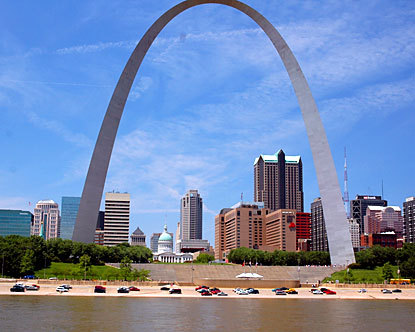US State of Missouri
Missouri — nicknamed The Show-Me State — is a U.S. state located in the Midwestern United States. Missouri is the 21st most extensive and the 18th most populous of the 50 United States. Missouri comprises 114 counties and the independent city of St. Louis.
The four largest urban areas are St. Louis, Kansas City, Springfield, and Columbia. Missouri's capital is Jefferson City. The land that is now Missouri was acquired from France as part of the Louisiana Purchase and became known as the Missouri Territory. Part of the Territory was admitted into the union as the 24th state on August 10, 1821.
Missouri's geography is highly varied. The northern part of the state lies in dissected till plains while the southern part lies in the Ozark Mountains (a dissected plateau), with the Missouri River dividing the two. The state lies at the intersection of the three greatest rivers of North America, with the confluence of the Mississippi and Missouri Rivers near St. Louis, and the confluence of the Ohio River with the Mississippi north of the Bootheel. The starting points of the Pony Express and Oregon Trail were both in Missouri. The mean center of United States population as of the 2010 Census is at the town of Plato in Texas County.
Missouri borders eight different states, as does its neighbor, Tennessee. No state in the U.S. touches more than eight states. Missouri is bounded on the north by Iowa; on the east, across the Mississippi River, by Illinois, Kentucky, and Tennessee; on the south by Arkansas; and on the west by Oklahoma, Kansas, and Nebraska (the last across the Missouri River). The two largest Missouri rivers are the Mississippi, which defines the eastern boundary of the state, and the Missouri River, which flows from west to east through the state, essentially connecting the two largest metros, Kansas City and St. Louis.
Although today the state is usually considered part of the Midwest, historically Missouri was considered by many to be a Southern state, chiefly because of the settlement of migrants from the South and its status as a slave state before the Civil War. The counties that made up "Little Dixie" were those along the Missouri River in the center of the state, settled by Southern migrants who held the greatest concentration of slaves.
In 2005, Missouri received 16,695,000 visitors to its national parks and other recreational areas totaling 202,000 acres (820 km2), giving it US$ 7.41 million in annual revenues, 26.6% of its operating expenditures.
Missouri generally has a humid continental climate ( Dfa) with cold winters and hot and humid summers. In the southern part of the state, particularly in the Bootheel, the climate turns into a humid subtropical climate. Located in the interior United States, Missouri often experiences extremes in temperatures. Without high mountains or oceans nearby to moderate temperature, its climate is alternately influenced by air from the cold Arctic and the hot and humid Gulf of Mexico. Missouri's highest recorded temperature is 118 °F (48 °C) at Warsaw and Union on July 14, 1954 while the lowest recorded temperature is −40 °F (−40 °C) also at Warsaw on February 13, 1905.
Missouri also receives extreme weather in the form of thunderstorms and tornadoes. The most recent tornado in the state to cause damage and casualties was the 2011 Joplin tornado, which destroyed roughly 1/3 of the city of Joplin. The tornado caused an estimated –3 billion in damages, killed 159 (+1 non-tornadic), and injured over 1,000 people. The tornado was the first EF5 to hit the state since 1957. The tornado was the deadliest in the U.S. since 1947, making it the 7th deadliest tornado in American history, but the 27th deadliest in the world. St. Louis and its suburbs also have a history of experiencing particularly severe tornadoes; the most recent memorable one being an EF4 tornado that damaged Lambert International Airport on April 22, 2011. In fact, one of the worst tornadoes in American history struck St. Louis on May 27, 1896.


Education in Missouri
The Missouri State Board of Education has general authority over all public education in the state of Missouri. It is made up of eight citizens appointed by the governor and confirmed by the Missouri Senate.
Primary and secondary schools
Education is compulsory from ages seven to seventeen per Statute 167.031, RSMo, states that any parent, guardian or other person having custody or control of a child between the ages of seven (7) and the compulsory attendance age for the district, must ensure that the child is enrolled in and regularly attends public, private, parochial school, home school or a combination of schools for the full term of the school year.
The term "compulsory attendance age for the district" shall mean seventeen (17) years of age or having successfully completed sixteen (16) credits towards high school graduation in all other cases. Children between the ages of five (5) and seven (7) are not required to be enrolled in school. However, if they are enrolled in a public school their parent, guardian or custodian must ensure that they regularly attend.
Missouri schools are commonly but not exclusively divided into three tiers of primary and secondary education: elementary school, middle school or junior high school and high school. The public schools system includes kindergarten to 12th grade. District territories are often complex in structure. In some cases, elementary, middle and junior high schools of a single district feed into high schools in another district. High school athletics and competitions are governed by the Missouri State High School Activities Association (MSHSAA).
Homeschooling is legal in Missouri and is an option to meet the compulsory education requirement. It is neither monitored nor regulated by the state's Department of Elementary and Secondary
Education
A supplemental education program, the Missouri Scholars Academy, provides an extracurricular learning experience for gifted high school students in the state of Missouri. The official MSA website describes the goals of the Academy to be as such: "The academy reflects Missouri's desire to strive for excellence in education at all levels. The program is based on the premise that Missouri's gifted youth must be provided with special opportunities for learning and personal development in order for them to realize their full potential." Another highly accepted gifted school is the Missouri Academy of Science, Mathematics and Computing, which is located at the Northwest Missouri State University.
Colleges and universities
Brookings Hall at Washington University in St. Louis.
The University of Missouri System is Missouri's statewide public university system. The flagship institution and largest university in the state is the University of Missouri in Columbia. The others in the system are University of Missouri–Kansas City, University of Missouri–St. Louis, and Missouri University of Science and Technology in Rolla.
During the late nineteenth and early twentieth century the state established a series of normal schools in each region of the state, originally named after the geographic districts: Northeast Missouri State University (now Truman State University) (1867), Central Missouri State University (now the University of Central Missouri) (1871), Southeast Missouri State University (1873), Southwest Missouri State University (now Missouri State University) (1905), Northwest Missouri State University (1905), Missouri Western State University (1915), and Missouri Southern State University (1937). Lincoln University and Harris-Stowe State University were established in the mid-nineteenth century and are historically black colleges and universities.
Among private institutions Washington University in St. Louis and Saint Louis University are two top ranked schools in the US. There are numerous junior colleges, trade schools, church universities and other private universities in the state. A. T. Still University was the first osteopathic medical school in the world. Hannibal-LaGrange University in Hannibal, MO, was one of the first colleges west of the Mississippi (founded 1858 in LaGrange, MO, and moved to Hannibal, MO, in 1928.
The 19th century border wars between Missouri and Kansas have continued as a sports rivalry between the University of Missouri and University of Kansas. The rivalry is chiefly expressed through football and basketball games between the two universities. It is the oldest college rivalry west of the Mississippi River and the second oldest in the nation. Each year when the universities meet to play, the game is coined "Border War." An exchange occurs following the game where the winner gets to take a historic Indian War Drum, which has been passed back and forth for decades.


